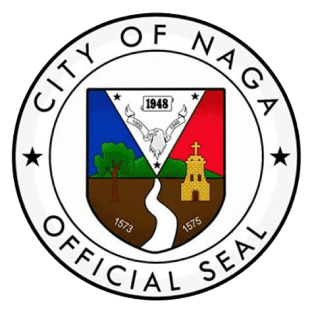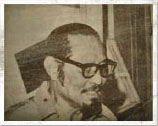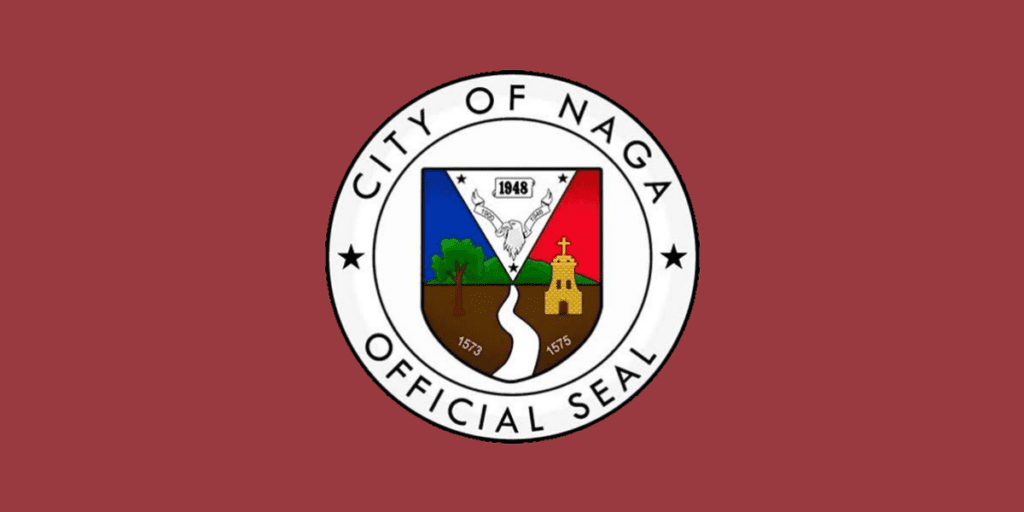Official Seal, Flag and March

The heraldic significance of the Coat of Arms of the City of Naga covers a span of 375 years – from 1573, the beginning of its recorded history, to 1948, the year of its inauguration as a regularly Chartered City by virtue of Republic Act No. 305.
“Naga: The Birth and Rebirth of a City” by Danilo Madrid Gerona
The Official Seal of the City of Naga
HIGHLIGHTS
- Dates in the Seal
- 1573-marks the year the Spaniards first arrived in Naga
- 1575-the year Ciudad de Caceres (later Nueva Caceres) was established
- 1900-American rule
- 1946-Philippine independence from the Americans
- 1948-Naga is Proclaimed Chartered City (Republic Act No. 305).
- Shapes and figures
- Narra (Naga) tree on a rice field -represents the native settlement discovered by Captain Juan de Salcedo in 1573
- Mt. Isarog and the Bicol River
- Castle -dominates the right side representing the Spanish city of Caceres, the center of power over South Luzon
- Triangle-represents the Katipunan. Naga was a focal point for rallying the region in the struggle against foreign domination.
- American eagle-symbolizes US rule

The Official Seal of the City of Naga, as finally approved by the Philippine Heraldry Committee, is essentially designed by Dr. Domingo Abella. Modifications made by the Committee affected the details of form and shape in line with an official standard and uniform pattern laid out by the Committee for all Official Seals in the country. No armorial device, however, was changed or eliminated.
The heraldic significance of the Coat of Arms of the City of Naga covers a span of 375 years – from 1573, the beginning of its recorded history, to 1948, the year of its inauguration as a regularly Chartered City by virtue of Republic Act No. 305. The years 1575, 1900 and 1946 are also recorded on the escutcheon because they mark important milestones, as it were, in the city’s existence.
The armorial devices used indicate the city’s most characteristic geographical landmarks – Mt. Isarog, the BicolRiver, and rice paddies. They likewise depict the cultural and religious background of its people, together with the two great Western influences which have left an indelible imprint upon the inhabitants’ tradition and character.
By impalement, the two original settlements which now constitute the City of Naga are symbolized at the base of the field. The native settlement of Naga discovered by Captain Juan de Salcedo on the banks of a tributary to the Bicol River in 1573 takes precedence on the dexter side. It is represented by a Narra or Naga tree growing luxuriantly on the vast expanse of rice paddies.
The dexter side’s blue background together with the green of the Narra tree represents the flourishing Oriental culture and paganism of the natives when Westerners first arrived.
The sinister side denotes the Spanish City of Caceres (later Nueva Caceres) founded by Captain Pedro de Chaves in 1575 not far from the native settlement of Naga by order of Governor Sande (for whose birthplace the city was named). This was the seat, not only of military, and later, of civil government (as shown by the Castle) but also of religious authority (the Cross on top of the Castle) over the whole of South Luzon.
The red of the sinister background symbolizes the blood shed by Spaniards and natives alike in the numerous clashes between the colonizers and their unwieldy and unwilling subjects, from the campaigns of Captain Chaves to the revolt of Corporal Elias Angeles, in the course of three centuries.
At the same time, the red of the background and the gold color of the Castle stand for the Gold and Red of monarchic Spain. In fess, the Isarog mountain, the Bicol River meandering from the mountain down to San Miguel Bay, and the rice fields bathed by the river along its course, all embrace both entities represented on the dexter and sinister sides — a geographical reality.
In the course of centuries, the two separate entities — native Naga and Castilian Nueva Caceres — expanded; through free admixture, by the end of the 19th century, the inhabitants of one and the other unit considered themselves residents of one and a common town. Then followed an official and religious recognition of the fusion of both units under the name Nueva Caceres at first, during the second decade of the present century, was changed to the native vocable Naga.
The upper of “chief” portion of the shield shows an equilateral triangle whose apex is at the “honor” point, representing the most common vehicle used by the Katipunan for the society’s symbols and insignias. The now City of Naga was the focal point for rallying the Bicol Region to the cause of the KKK against foreign domination, and it was in the old Nueva Caceres where the martyrs of 1897 were tortured prior to their shipment to Manila – never to return. It was also in the old Nueva Caceres where Elias Angeles and his men caused, by force of arms, the surrender of the last Spanish authority in Ambos Camarines.
Borne upon the triangle is the American eagle symbolizing Uncle Sam’s rule after the bloody events of the revolution. A scroll borne by the eagle carries the year 1900, when the first American troops established themselves locally, and the year 1946 when independence for the whole country was proclaimed.
The white color of the triangular field represents the enlightened rule of America under whose aegis the community prepared itself for its place of honor among the chartered cities of the country. On top of all the symbols and armorial devices, occupying the uppermost center of the “chief” portion, is a scroll bearing the year 1948 – the culmination, as it were, of the fused communities’ (Naga and Nueva Caceres) recorded history of 375 years: the year of its proclamation as the Chartered City of Naga.
Reprinted from the book “Naga: The Birth and Rebirth of a City” by Danilo Madrid Gerona
Below: The Official Seal of the City of Naga as rendered through the years.
The Flag

Heart of Bicol March (Naga City March)
Words by: Bienvenido N. Santos
Music by: Meriem R. Palacio
Heart of Bicol rich in culture
and history you call to mind
symbols of the rarest nature
a tree, a river and a shrine
City of sounds we hear your voices
in church, in street, and market place
in campus din and river noise
that shapes our lives, and guilds our days
Heart of Bicol, Naga City
In times of draught, in fire and flood
We see the years of promise plenty
In this cathedral town of God
Bless our city queen of graces
Touch this heart anew with love
Pour upon our upturned faces
all the music of your love
Pour upon our upturned faces
all the music of your love